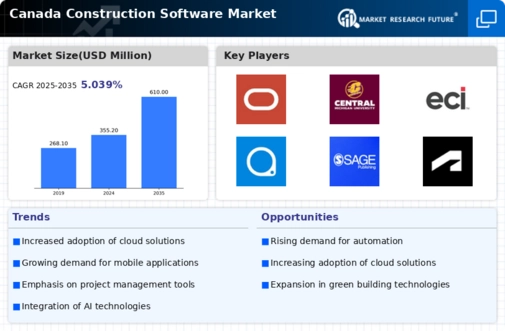Focus on Data Analytics and Reporting
The construction software market in Canada is increasingly driven by a focus on data analytics and reporting capabilities. As construction firms seek to leverage data for informed decision-making, software solutions that provide robust analytics tools are gaining traction. In 2025, it is projected that analytics-driven software will account for around 25% of the construction software market. This emphasis on data analytics allows companies to identify trends, optimize resource allocation, and enhance project outcomes. As a result, the construction software market is likely to expand, with a growing number of firms investing in solutions that offer advanced reporting features and data visualization tools.
Regulatory Compliance and Safety Standards
The construction software market in Canada is significantly influenced by the stringent regulatory compliance and safety standards imposed by governmental bodies. As construction projects must adhere to various codes and regulations, software solutions that facilitate compliance tracking and reporting are in high demand. In 2025, it is estimated that compliance-related software will account for approximately 20% of the total construction software market. This driver highlights the necessity for construction firms to invest in software that not only ensures adherence to safety regulations but also mitigates risks associated with non-compliance. Consequently, the construction software market is poised for growth as companies seek to enhance their compliance capabilities.
Rising Demand for Project Management Tools
The construction software market in Canada experiences a notable surge in demand for project management tools. This trend is driven by the increasing complexity of construction projects, which necessitates efficient planning, scheduling, and resource allocation. In 2025, the market for project management software is projected to reach approximately $1.5 billion, reflecting a growth rate of around 12% annually. Construction firms are increasingly adopting these tools to enhance collaboration among stakeholders, streamline workflows, and improve overall project visibility. As a result, the construction software market is likely to witness a significant uptick in the adoption of specialized project management solutions, which cater to the unique needs of the industry.
Adoption of Mobile Technology in Construction
The construction software market in Canada is witnessing a transformative shift with the adoption of mobile technology. As construction professionals increasingly rely on mobile devices for real-time communication and data access, software solutions that offer mobile compatibility are becoming essential. In 2025, it is estimated that mobile-enabled construction software will represent approximately 30% of the overall market. This trend indicates a growing preference for on-site access to project information, enabling teams to make informed decisions quickly. Consequently, the construction software market is likely to see a rise in demand for mobile applications that enhance productivity and facilitate seamless collaboration among project teams.
Increased Investment in Infrastructure Development
The construction software market in Canada is poised for growth due to increased investment in infrastructure development. Government initiatives aimed at enhancing transportation networks, public facilities, and utilities are driving demand for construction software solutions. In 2025, infrastructure spending is projected to exceed $100 billion, creating a favorable environment for software providers. This influx of capital encourages construction firms to adopt advanced software tools that improve project efficiency and cost management. As a result, the construction software market is likely to expand, with a focus on solutions that support large-scale infrastructure projects and facilitate collaboration among various stakeholders.

























Leave a Comment